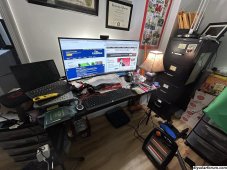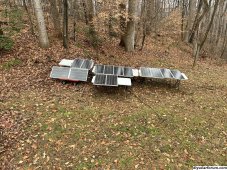Holdontight
New Member
I have 2 AC180s and have been using them for just over three weeks. I use one AC180 to run my home office and to power a chest freezer when I have spare power. The other AC180 is on standby for power outages. I plan to swap both units occasionally to even out the wear on the batteries.
I have over paneled my system with 1400W of Renogy solar panels. I hope to achieve a charge rate of 300W for as much of the day as possible. I did this in part because of tree coverage here and because Solar panels are quite a bit cheaper than they were 10 years ago. I built my system in part for backup power and to offset a small amount of our electricity usage. So far I produce a total 1KW most days and so the offset is tiny. I hope to squeeze a little more from my system shortly.
Parallel or serial
Each panel has an open circuit of 20V and so I have 2 in series to provide 40V and it looks like I’m seeing a limit of around 5.5A. The most I’ve seen so far is 280W input on the AC180. I plan to configure the solar array for 3 panels in series for a max voltage of 60V in the hopes of achieving more. I think my long run of poor quality MC4 cables isn’t helping much.
Cheap MC4’s
I now realize that some cheaper MC4 cables on Amazon are rubbish. I need to replace my long run of cables in the hopes of getting more than 5.5A though the system.
What I like so far about the AC180
I love the ability to run any 110/120V appliance in my home. I’ve been able to run a small space heater, air fryer, TV, electric blanket, Microwave, lighting and anything I could find. With 1000W storage in a box of its size makes it useful and isn’t too heavy to move around.
Price. I paid $687.94 for mine. That’s a battery, inverter, MPPT Controller and UPS in one package. I paid over $800 for a Renogy 100Ah LiPo4 battery just over 4 years ago.
Bluetti’s customer service. After purchasing my first AC180 at $793.94. Imagine how annoyed I was at seeing the price drop to $687.94 a week later. Bluetti refunded the price difference after a brief exchange with their customer service dept. Thanks Luna at Bluetti.
Timeout for the LCD is configurable. I’ve set mine to 5 minutes and so that’s more useful than I’ve seen before. You can set it to stay on permanently.
Internal charger with a standard IEC desktop computer cable. These cables are easy to find if you leave yours at home.
What’s to improve on the AC180?
The internal electronics appear to run on battery even if grid and solar is available. This will eventually drop the battery percentage from 100% to 99%, and a recharge follows.
Solar input is disconnected when the battery is full. You can have ample solar power and the AC180 won’t benefit from solar unless the battery is less than 100%
The UPS feature works well. I wish the internal electronics were supplied by grid power and not battery power. This would stop the occasional cycling of the battery between 99 and 100%
I’m not sure if the constant cycling of the battery between 99 and 100% is good for LiPo4 batteries. Time will tell.
Anyone with the Bluetooth app and in Bluetooth range of my units can mess with my loads. I hope Bluetti will improve the security of this in future releases.
Questions for the Forum
I love the flexibility of an above ground solar system. It’s not too much of an issue for me to add/remove and swap panels.
Do any of you configure and test new solar setups?
Do any of you have a plug and play solution for your solar arrays?
Do any of you have any problems running the input of the AC180 at its maximum input wattage for long periods?
Pictures. My home office. The AC180 can run this heater without issue. My oversized solar array to capture as much as i can on cloudy days
https://bit.ly/33Onq63
I have over paneled my system with 1400W of Renogy solar panels. I hope to achieve a charge rate of 300W for as much of the day as possible. I did this in part because of tree coverage here and because Solar panels are quite a bit cheaper than they were 10 years ago. I built my system in part for backup power and to offset a small amount of our electricity usage. So far I produce a total 1KW most days and so the offset is tiny. I hope to squeeze a little more from my system shortly.
Parallel or serial
Each panel has an open circuit of 20V and so I have 2 in series to provide 40V and it looks like I’m seeing a limit of around 5.5A. The most I’ve seen so far is 280W input on the AC180. I plan to configure the solar array for 3 panels in series for a max voltage of 60V in the hopes of achieving more. I think my long run of poor quality MC4 cables isn’t helping much.
Cheap MC4’s
I now realize that some cheaper MC4 cables on Amazon are rubbish. I need to replace my long run of cables in the hopes of getting more than 5.5A though the system.
What I like so far about the AC180
I love the ability to run any 110/120V appliance in my home. I’ve been able to run a small space heater, air fryer, TV, electric blanket, Microwave, lighting and anything I could find. With 1000W storage in a box of its size makes it useful and isn’t too heavy to move around.
Price. I paid $687.94 for mine. That’s a battery, inverter, MPPT Controller and UPS in one package. I paid over $800 for a Renogy 100Ah LiPo4 battery just over 4 years ago.
Bluetti’s customer service. After purchasing my first AC180 at $793.94. Imagine how annoyed I was at seeing the price drop to $687.94 a week later. Bluetti refunded the price difference after a brief exchange with their customer service dept. Thanks Luna at Bluetti.
Timeout for the LCD is configurable. I’ve set mine to 5 minutes and so that’s more useful than I’ve seen before. You can set it to stay on permanently.
Internal charger with a standard IEC desktop computer cable. These cables are easy to find if you leave yours at home.
What’s to improve on the AC180?
The internal electronics appear to run on battery even if grid and solar is available. This will eventually drop the battery percentage from 100% to 99%, and a recharge follows.
Solar input is disconnected when the battery is full. You can have ample solar power and the AC180 won’t benefit from solar unless the battery is less than 100%
The UPS feature works well. I wish the internal electronics were supplied by grid power and not battery power. This would stop the occasional cycling of the battery between 99 and 100%
I’m not sure if the constant cycling of the battery between 99 and 100% is good for LiPo4 batteries. Time will tell.
Anyone with the Bluetooth app and in Bluetooth range of my units can mess with my loads. I hope Bluetti will improve the security of this in future releases.
Questions for the Forum
I love the flexibility of an above ground solar system. It’s not too much of an issue for me to add/remove and swap panels.
Do any of you configure and test new solar setups?
Do any of you have a plug and play solution for your solar arrays?
Do any of you have any problems running the input of the AC180 at its maximum input wattage for long periods?
Pictures. My home office. The AC180 can run this heater without issue. My oversized solar array to capture as much as i can on cloudy days
https://bit.ly/33Onq63




